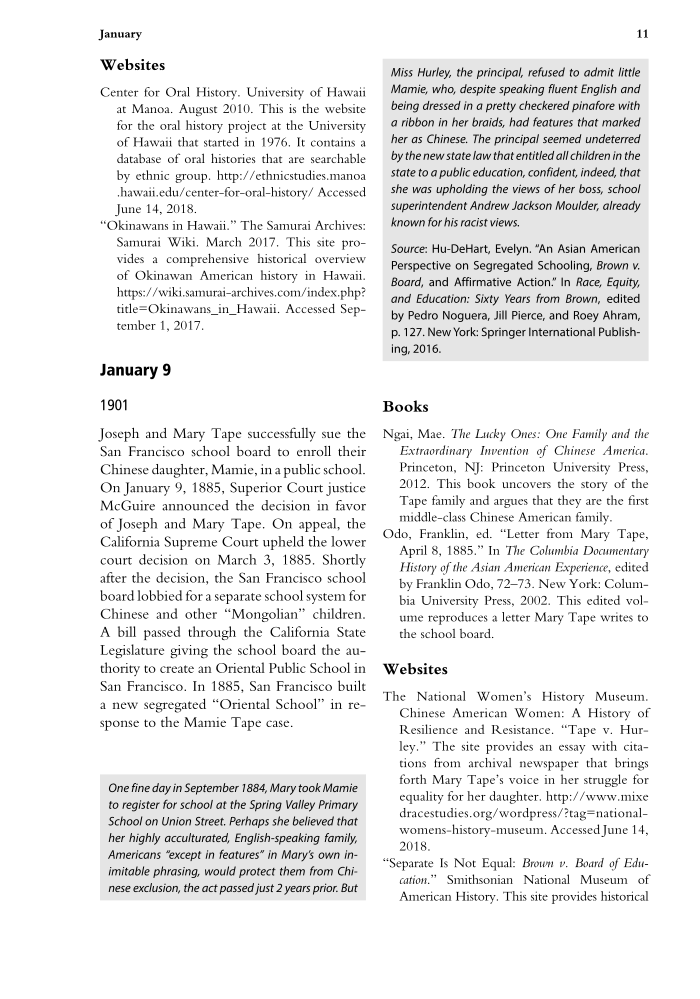January 11 Websites Center for Oral History. University of Hawaii at Manoa. August 2010. This is the website for the oral history project at the University of Hawaii that started in 1976. It contains a database of oral histories that are searchable by ethnic group. http://ethnicstudies.manoa .hawaii.edu/center-for-oral-history/ Accessed June 14, 2018. “Okinawans in Hawaii.” The Samurai Archives: Samurai Wiki. March 2017. This site pro- vides a comprehensive historical overview of Okinawan American history in Hawaii. https://wiki.samurai-archives.com/index.php? title=Okinawans_in_Hawaii. Accessed Sep- tember 1, 2017. January 9 1901 Joseph and Mary Tape successfully sue the San Francisco school board to enroll their Chinese daughter, Mamie, in a public school. On January 9, 1885, Superior Court justice McGuire announced the decision in favor of Joseph and Mary Tape. On appeal, the California Supreme Court upheld the lower court decision on March 3, 1885. Shortly after the decision, the San Francisco school board lobbied for a separate school system for Chinese and other “Mongolian” children. A bill passed through the California State Legislature giving the school board the au- thority to create an Oriental Public School in San Francisco. In 1885, San Francisco built a new segregated “Oriental School” in re- sponse to the Mamie Tape case. Books Ngai, Mae. The Lucky Ones: One Family and the Extraordinary Invention of Chinese America . Princeton, NJ: Princeton University Press, 2012. This book uncovers the story of the Tape family and argues that they are the fi rst middle-class Chinese American family. Odo, Franklin, ed. “Letter from Mary Tape, April 8, 1885.” In The Columbia Documentary History of the Asian American Experience , edited by Franklin Odo, 72–73 . New York: Colum- bia University Press, 2002. This edited vol- ume reproduces a letter Mary Tape writes to the school board. Websites The National Women’s History Museum. Chinese American Women: A History of Resilience and Resistance. “Tape v. Hur- ley.” The site provides an essay with cita- tions from archival newspaper that brings forth Mary Tape’s voice in her struggle for equality for her daughter. http://www.mixe dracestudies.org/wordpress/?tag=national- womens-history-museum. Accessed June 14, 2018. “Separate Is Not Equal: Brown v. Board of Edu- cation .” Smithsonian National Museum of American History. This site provides historical One fine day in September 1884, Mary took Mamie to register for school at the Spring Valley Primary School on Union Street. Perhaps she believed that her highly acculturated, English-speaking family, Americans “except in features” in Mary’s own in- imitable phrasing, would protect them from Chi- nese exclusion, the act passed just 2 years prior. But Miss Hurley, the principal, refused to admit little Mamie, who, despite speaking fluent English and being dressed in a pretty checkered pinafore with a ribbon in her braids, had features that marked her as Chinese. The principal seemed undeterred by the new state law that entitled all children in the state to a public education, confident, indeed, that she was upholding the views of her boss, school superintendent Andrew Jackson Moulder, already known for his racist views. Source: Hu-DeHart, Evelyn. “An Asian American Perspective on Segregated Schooling, Brown v. Board, and Affirmative Action.” In Race, Equity, and Education: Sixty Years from Brown, edited by Pedro Noguera, Jill Pierce, and Roey Ahram, p. 127. New York: Springer International Publish- ing, 2016.
Document Details My Account Print multiple pages
Print
You have printed 0 times in the last 24 hours.
Your print count will reset on at .
You may print 0 more time(s) before then.
You may print a maximum of 0 pages at a time.






























































































































































































































































































































































































































































































